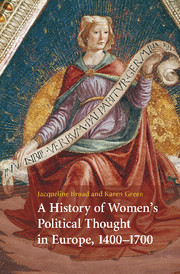Book contents
- Frontmatter
- Contents
- Preface
- Introduction
- 1 Christine de Pizan
- 2 Women of the Italian Renaissance
- 3 From Anne de Beaujeu to Marguerite de Navarre
- 4 Queen Elizabeth I of England
- 5 From the Reformation to Marie le Jars de Gournay
- 6 Women of the English civil war era
- 7 Quaker women
- 8 The Fronde and Madeleine de Scudéry
- 9 Margaret Cavendish, Duchess of Newcastle
- 10 Women of the Glorious Revolution
- 11 Women of late seventeenth-century France
- 12 Mary Astell
- Conclusion
- Bibliography
- Index
1 - Christine de Pizan
Published online by Cambridge University Press: 02 July 2009
- Frontmatter
- Contents
- Preface
- Introduction
- 1 Christine de Pizan
- 2 Women of the Italian Renaissance
- 3 From Anne de Beaujeu to Marguerite de Navarre
- 4 Queen Elizabeth I of England
- 5 From the Reformation to Marie le Jars de Gournay
- 6 Women of the English civil war era
- 7 Quaker women
- 8 The Fronde and Madeleine de Scudéry
- 9 Margaret Cavendish, Duchess of Newcastle
- 10 Women of the Glorious Revolution
- 11 Women of late seventeenth-century France
- 12 Mary Astell
- Conclusion
- Bibliography
- Index
Summary
Christine de Pizan (1364–1430) lived in France from the reign of Charles V, through the madness of Charles VI, until the year in which the appearance of Joan of Arc secured the succession of Charles VII. Christine thus suffered the effects of the conflict between the Armagnacs and Burgundians, which had one of its murderous climaxes in the Cabochien uprising of 1413. During this period, she wrote a number of works promoting princely virtue, often intended for Louis of Guyenne, the eldest son of Charles VI, and Isabeau de Bavière, who, she hoped, might ultimately take over the government and secure the peace. She also wrote during a period that famously consolidated the authority of vernacular literature. Against the background of the dissemination of translations of classical thought to a courtly and lay audience, promoted by Charles V, Christine was able to establish herself as an authoritative female writer. In 1403, Philip the Bold, Duke of Burgundy, invited her to write a history of Charles V. In response Christine painted an idealised portrait of this king, whose prudence, justice, and capacity to maintain the peace and prosperity of France constituted for her the ideal princely government. Christine also wrote works defending women, for which she is now best known. In this chapter, we examine the way in which her meditation on the nature of good government interconnects with her defence of women's authority.
- Type
- Chapter
- Information
- Publisher: Cambridge University PressPrint publication year: 2009

